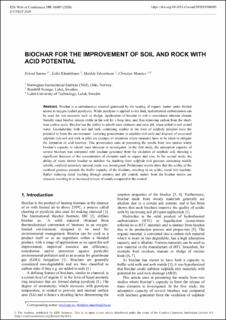| dc.description.abstract | Biochar is a carbonaceous material generated by the heating of organic matter under limited access to oxygen (called pyrolysis). While pyrolysis is applied to dry feed, hydrothermal carbonization can be used for wet materials such as sludge. Application of biochar to soil is considered inherent climate friendly since biochar remain stable in the soil for a long time, and thus removing carbon from the short-term carbon cycle. Biochar has the ability to adsorb trace elements and raise pH, when added to soil or/and water. Geomaterials, both soil and rock, containing sulphur in the form of sulphide minerals have the potential to harm the environment. Lowering groundwater in sulphide rich soils and disposal of excavated sulphide rich soil and rock in piles are example of situations where measures have to be taken to mitigate the formation of acid leachate. This presentation aims at presenting the results from two studies where biochar’s capacity to adsorb trace elements is investigated. In the first study, the adsorption capacity of several biochars was compared with leachate generated from the oxidation of sulphide soil, showing a significant decrease of the concentration of elements such as copper and zinc. In the second study, the ability of waste timber biochar to stabilize the leaching from sulphide rich gneisses containing readily soluble, oxidized secondary mineral crusts was investigated. Preliminary results show that the acidity of the oxidized gneisses exceeds the buffer capacity of the biochars, resulting in an acidic, metal rich leachate. Rather reducing metal leaching through sorption and pH control, metals from the biochar matrix are released, resulting in an increased release of metals compared to the control. | |
